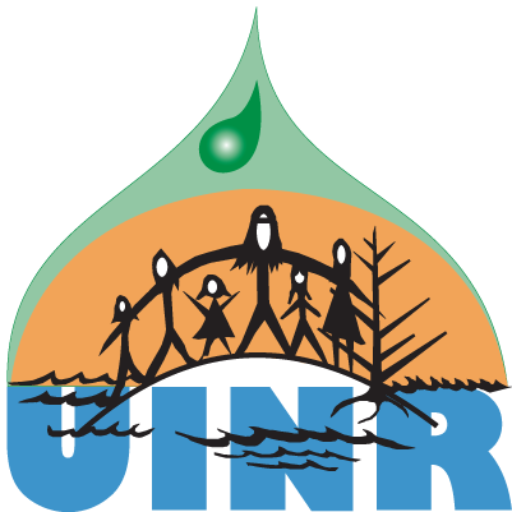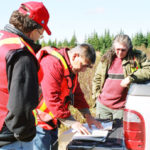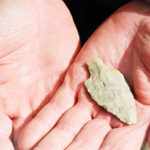By Clifford Paul
 Armed with a series of maps, a compass, and a handy GPS device, Mi’kmaq archaeologist Roger Lewis attempts to recreate a 4500-year old story deep in heart of the Cape Breton Highlands. Using investigative techniques, combined with contour maps, Lewis is recreating a scene as to how a Mi’kmaq arrowhead made its way to one of the Wreck Cove spillways.
Armed with a series of maps, a compass, and a handy GPS device, Mi’kmaq archaeologist Roger Lewis attempts to recreate a 4500-year old story deep in heart of the Cape Breton Highlands. Using investigative techniques, combined with contour maps, Lewis is recreating a scene as to how a Mi’kmaq arrowhead made its way to one of the Wreck Cove spillways.
The story of how the arrowhead was found is much simpler. Five years ago, a Mi’kmaq moose hunter from the Annapolis Valley turned on to a side road next to a brook, he looked down, and right next to his boot was the arrowhead.
“Five thousand years ago, this little brook was a raging river,” Lewis noted, spreading his maps across the tailgate of his silver Ford Ranger pickup. “Our ancestors are like every other people. They took the easiest route inland from the coast, and that was by water – coming into the Wreck Cove spillway through Indian Brook (a strong flowing brook that empties into the Atlantic Ocean).”
One of our ancestors must have taken a shot at a big game animal, leaving evidence upon the land, only to be discovered some 4500 years later. This ancient hunter must have been travelling with a family group from the Atlantic coast and up Indian Brook which takes them into the northern interior of Unama’ki.
Nova Scotia archaeologists determine this event as something that happened during the Archaic Period (some 9000-2500 years ago). The arrowhead is officially referenced as a “contracting stem projectile point” noted by the handiwork of its tapered design–a product of the technology used during the Maritime Archaic Period (5000-3500 years ago). From the Mi’kmaq perspective, this period is referred as “Mu Awsami Sagiwe’kâ” literally translated “not so recent people.”
The arrowhead is made of domestic rhyolite quarried from Ingonish Island. “This material has a distribution from Ingonish through Cape Breton, Antigonish and Pictou,” Lewis noted. Artifacts made from this very same rhyolite can be found in those areas. Perhaps this distribution coincides with ancient migration routes for caribou.
At the time, the territory was experiencing great climatic change. Sea levels rose dramatically, consequently submerging much of the Mi’kmaq ancestral past in terms of artifactual evidence. The region became covered by mixed forests and temperatures were gradually increasing. Food varied according to season, with the Mi’kmaq matching their migrations to that of the natural resources available at the time. Fish and sea mammals were in abundance along the Atlantic coast. River systems provided transportation and access to fish and animals such as caribou, moose, deer, and beaver to name a few.
“Thank you my ancient brother man,” Lewis concluded, citing the poetry of Nora Bromley’s Ancient Brother Man, 1973. “I grasp within my hand a perfect tool, so long ago chipped carefully from stone….I touch with care its edges keen and fine. For once where you once placed your thumb there now is mine!”
Roger Lewis, from Indianbrook First Nation, is the Mi’kmaq Archaeological Researcher for Kwilmuk Maw-klusuaqn, Mi’kmaq Rights Initiative and is responsible for the archaeological component of KMK’s research activities. Roger has been conducting reconnaissance and assessment of pre-contact and historical archaeological sites found in Nova Scotia and will document Mi’kmaq cultural activities in support of negotiations.
clifford@uinr.ca
As man today, I greet you ancient brother man
and point with gratitude to these artifacts
you made in eons past.
The signature of man’s slow rise on each and
every tool, each point, and each axe.
We can sense the human impact still.
Who smoked this pipe? Â Who played this flute?
Who used this hoe? Who threw this spear?
And was it made for deer or foe?
As man today, I kneel upon a mountain circled flat
to feel ancient ashes yellow and see a kinship gift
for which you have left for me.
I grasp within my hand a perfect tool, so long ago chipped carefully from stone and now but for the timing of our fates it might have been my own.
I touch with care its edges keen and fine.
Where once you placed your thumb
there now is mine!
by Nora Bromley, 1973
From UINR Marten – Vol.2. Issue.4 – Winter 2006


